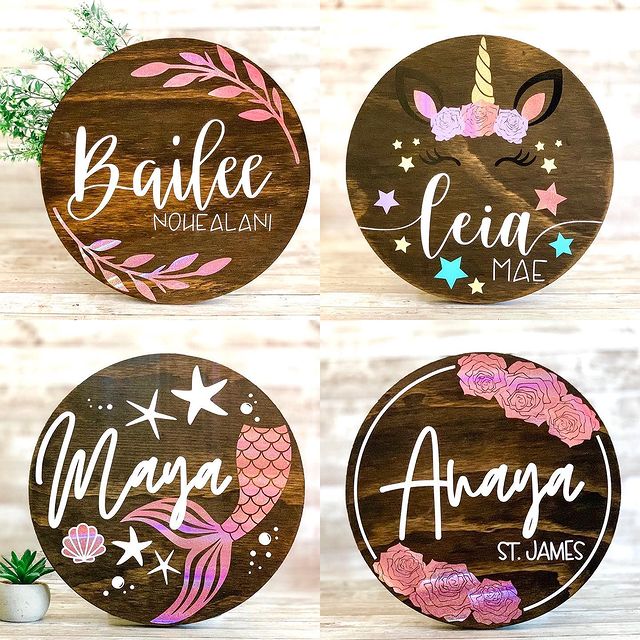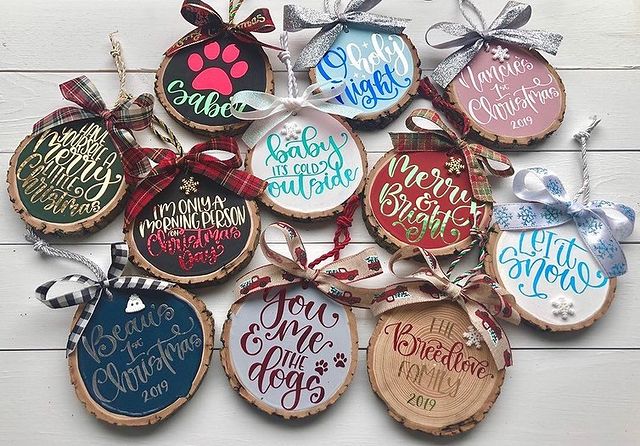Both of my prints are mess up because of transfer vinyl did work the printer bites the material so if I get to buy the material again? Is not I’m going to put in the trash 🗑️ because is not good for me.

How To Get Vinyl To Stick To Wood?
Posted By TeckWrap Craft On December 02, 2023

Table Of Contents
You may have a lingering question such as, “Can vinyl stick to wood”? Yes, definitely wood and vinyl are a good crafting match. Whatever type of wood you want to use, there is a suitable vinyl that you can use to decorate it. Vinyl can certainly adhere to any wooden surface.
You can make both indoor and outdoor signs with vinyl and wood. This article will guide you on how to apply vinyl on wood and how to get vinyl to stick to wood long-term. If you are ready, keep reading!
Applying Vinyl On Wood
Many crafters and even business owners turn to vinyl for their wood signs instead of paint. This has been the trend for quite some time now. The reasons for this shift outway the preference for painted signs. Crafters and business owners can save money and time with vinyl.
Here are the common reasons for vinyl preference:
- Vinyl presents the same effect as paint on wood
- Vinyl is easier, faster, and less messy to work with
- There are more colors, styles, and font options
- Wooden signs are more unique
- Mistakes are cheaper with vinyl than using paint
- Wood projects using vinyl can be remade with the same design and quality each time

With vinyl, you can make tons of wooden projects. Vinyl comes in different colors and patterns for you to choose from. You can pair vinyl and wood to make the following:
- Wood signs (stained wood, untreated wood, or painted wood surface)
- Stencils
- Enhancing old furniture
- Toy blocks for young children
- Many more
Vinyl Application Procedure
TeckWrap Craft’s vinyl collection of permanent adhesive vinyl and heat transfer vinyl (HTV) can be applied to wooden surfaces to make wood signs. If you want a guide on how to choose the appropriate vinyl for your wooden project, you may be interested to read this blog article about the best vinyl for wood signs.

Adhesive vinyl and heat transfer vinyl are applied differently on wood. This article will cover two ways on how to get vinyl to stick to wood using permanent adhesive vinyl and heat transfer vinyl. The supplies you need for this project are listed below:
- Wood
- TeckWrap Craft adhesive vinyl and heat transfer vinyl
- TeckWrap Craft transfer tape
- 150 grit sandpaper
- Base coat wood treatment (polycrylic or acrylic paint)
- TeckWrap Craft weeding tool
- Iron, heat press, or mini iron
- TeckWrap Craft squeegee
- Teflon sheet
Using Adhesive Vinyl
If you are a beginning crafter, you may want to try working with adhesive vinyl for your wood sign projects. Adhesive vinyl is easier and faster to work with than HTV. There is a lesser chance that you can make a mistake with adhesive vinyl.
The first step is to sand down the wood whether it is raw wood or stained wood. Vinyl sticks even to untreated wood. Sanding a wooden surface makes the uneven surface into a smoother surface which will make the vinyl stick better.
The next step is to treat the wood you are working on. In treating the raw wood surface, you can apply a coat of polycrylic, wood stain, or acrylic paint that the vinyl can grip onto. All these primer or base coat treatments are available for purchase in most craft stores.
It is important that you give the primer 24-48 hours to dry and completely set before you proceed to the next step. Next, it is time to apply your vinyl decal. If you are a beginner and you don’t know how to make a vinyl decal, you may find this beginner’s guide for crafting helpful.
After you have created, cut, and weeded your design, you can now apply it to your wooden surface. When applying vinyl make sure that you have applied transfer tape to your decal. Transfer your decal with a firm grip and burnish with your squeegee. That’s it! Your wood project is done!
Using Heat Transfer Vinyl
If you are looking for a vinyl that can make your wood sign look like a paint finish, you may try using heat transfer vinyl or iron-on vinyl. The first step is similar to an adhesive vinyl application, which is sanding the wooden surface to make it smooth.
Your decal should also be ready - cut and weeded for immediate transfer. When working with heat transfer vinyl, you no longer need a transfer tape. Instead, insert a Teflon sheet or parchment paper between the wood and iron. It should work fine as a layer of protection.

In applying heat to wood, you must preheat your iron or heat press. You may refer to this guide on how to apply heat using a heat press with the appropriate temperature setting. When you see your carrier sheet curl this signals that your vinyl has completely adhered to the surface.
Most heat transfer vinyl is cold peel which means you should remove the carrier sheet from your heat transfer vinyl after a few seconds of application. Keep in mind that not all heat transfer vinyl is a cold peel. You have to check with your vinyl manufacturer if your HTV is a warm or cold peel.
If you want to use flock, glitter, or foil heat transfer vinyl, you can expect a paint-like finish on your wood project. However, there is a downside to using HTV and that is the possibility of the vinyl’s adhesive leaking around the decal’s edges.
Reasons Why Vinyl Is Not Sticking To Wood
There are several reasons or challenges why your vinyl may not stick well to wood. Here are some of the possible reasons you could look into:
- Wrong choice of vinyl
- Poor wood surface quality
- Bare wood
- Duration of heat application
- The paint hasn't completely cured
- Very sticky transfer tape
- Wrong paint used

Wrong Vinyl
In choosing the right vinyl for wood projects, there are certain considerations for not all vinyl can stick to wood. HTV better adheres to rough wood or rough surfaces than adhesive vinyl. You may be comfortable using adhesive vinyl, but if you want your wood projects to work out, you should try HTV.
With adhesive vinyl, you still need to apply a sealant to secure the vinyl on the wood. However, with HTV this is not necessary. Aside from this, HTV looks thinner on wood than adhesive vinyl which makes it look like fresh paint.
Poor Wooden Surface
Generally speaking, wood is a rough surface. The wood may have splinters, grooves, or holes that make it uneven. This would be a challenge to add vinyl to wood completely. To avoid this problem, it is best to sand your wood and smoothen it out prior to the vinyl application regardless if it is adhesive vinyl or HTV.
Bare Wood
Sanding down your wood at times, may not be enough. The wood may stay uneven despite sanding it several times. You don't have to give up just yet. There is still something you can do to remedy this situation.
Uneven surfaces cause a lot of friction. To minimize this, you can apply a layer of varnish, paint, or other materials that serves as a protective coating. Applying a protective coat on your wood not only makes the surface smoother, but it also protects it from weather damage. Use varnish or transparent stain if you want the wood to retain its natural look.
Duration Of Heat Application
When exposing vinyl to heat, you have to consider how long it needs to be exposed to it. HTV may burn if you expose it to heat for a very long time. You will end up destroying the wood in the process. HTV will stick well if the timing is just right.
Not Completely Cured Painted Wood
It is very important that you wait for the paint to completely dry out and set before putting vinyl to wood. When you have fresh paint on your project it can cause the emission of volatile organic compounds (VOCs).

Using Sticky Transfer Tape
If you find yourself struggling to remove the vinyl decal from the transfer tape despite countless burnishing, there are remedies to this problem. You can try leaving your decal on the wooden surface for a few minutes to let the vinyl adhesive bond with the wood. After 10-20 minutes or so, you may slowly remove the transfer tape
If this tip won’t work, you can try sticking the transfer tape to jeans or other fabrics to make it less sticky. Remove the fibers that are left on the transfer tape and try reapplying the vinyl to your wood. Your last resort would be to purchase a less sticky transfer tape for your project.
Not Using Acrylic Paint
When buying paint for your wooden surfaces, you have to check if it is stain resistant or not. Stain-resistant paints are a bit easier to clean. These paints resist vinyl and applying vinyl can be difficult. It is advisable to use acrylic paint, semi-gloss paint, high gloss paint, and stain paints for projects on wood.

More Tips On How To Get Vinyl To Stick To Wood
You now know the reasons why your vinyl won't stick to wood. Listed below are a few tips that have already been mentioned above as well as more tips that can make your wood crafting project more enjoyable and stress-free.
Sanded And Painted Wood
When applying vinyl on wood make sure that it is sanded. The wood should also be clean and the paint applied has cured completely. For adhesive vinyl, you have to make sure that you are pressing firmly with the squeegee. For HTV, you need to give the vinyl time to transfer completely. Don't be in a hurry.
Use The Right Type Of Vinyl
For your wooden projects, make sure that you choose permanent adhesive vinyl and not removable adhesive vinyl. Permanent vinyl has a stronger adhesive and is glossier while removable vinyl has a matte finish and can easily peel off.
Choose vinyl that has a solvent-based adhesive instead of acrylic. Solvent-based adhesives can adhere better to porous surfaces such as wood. Though, you may need to weigh your options for they are more expensive than acrylic ones.
Use The Right Transfer Tape
Also, you have to check that you are not using paper transfer tape. If you are using one, you can moisten the back of the transfer paper with application fluid. The application fluid weakens the bond between the vinyl and tape. It softens the tape’s adhesive.
Applying A Sealant
If you are creating signs for outdoor use, you can make the vinyl designs more durable by applying a clear coat (Mod Podge or Krylon). You can read more about sealing vinyl on wood here.

Frequently Asked Questions
Q. How do I make vinyl stick to wood?
More Articles You’ll Find Helpful
Keep Crafting with Us
- Choosing a selection results in a full page refresh.
!







